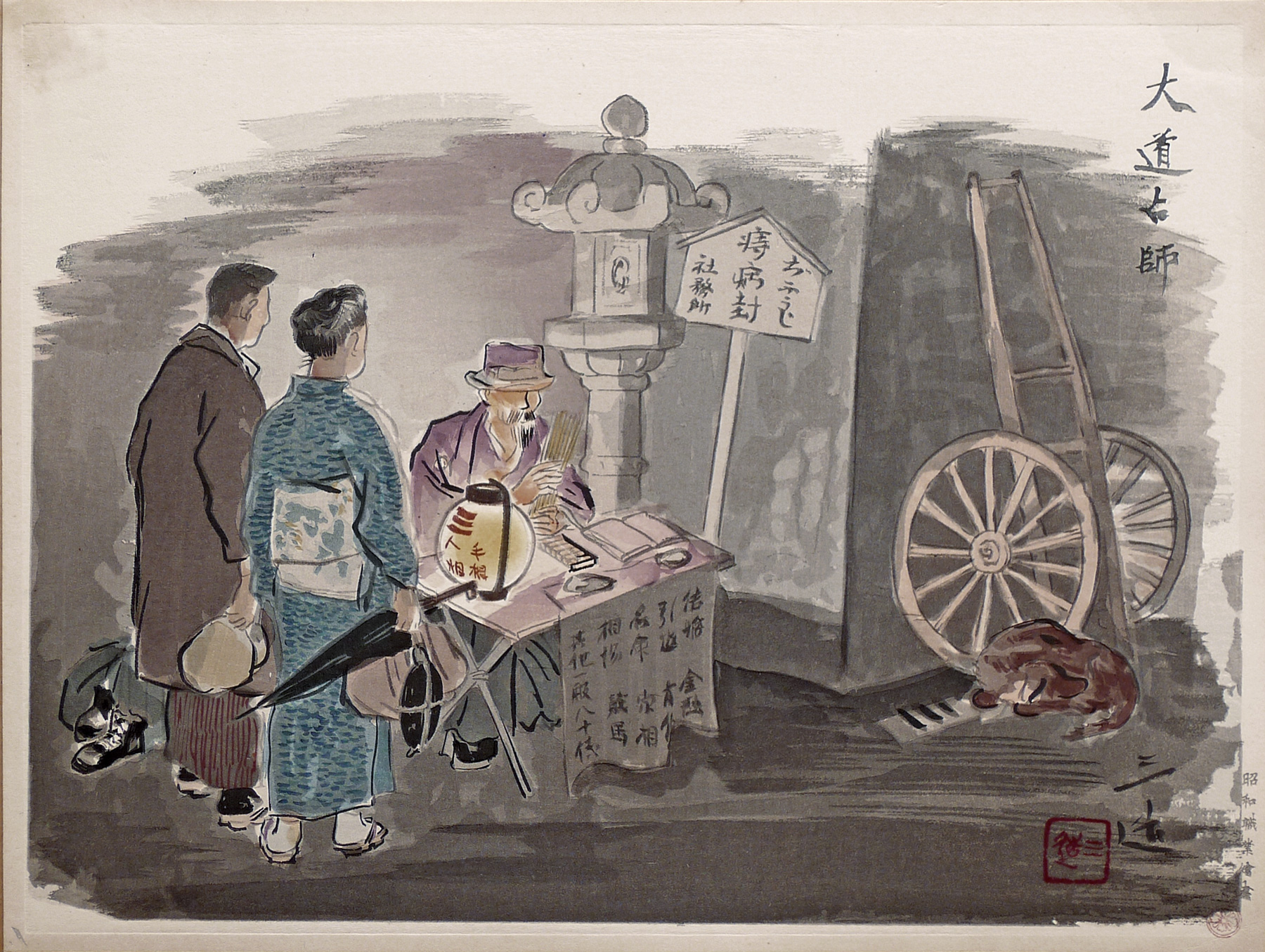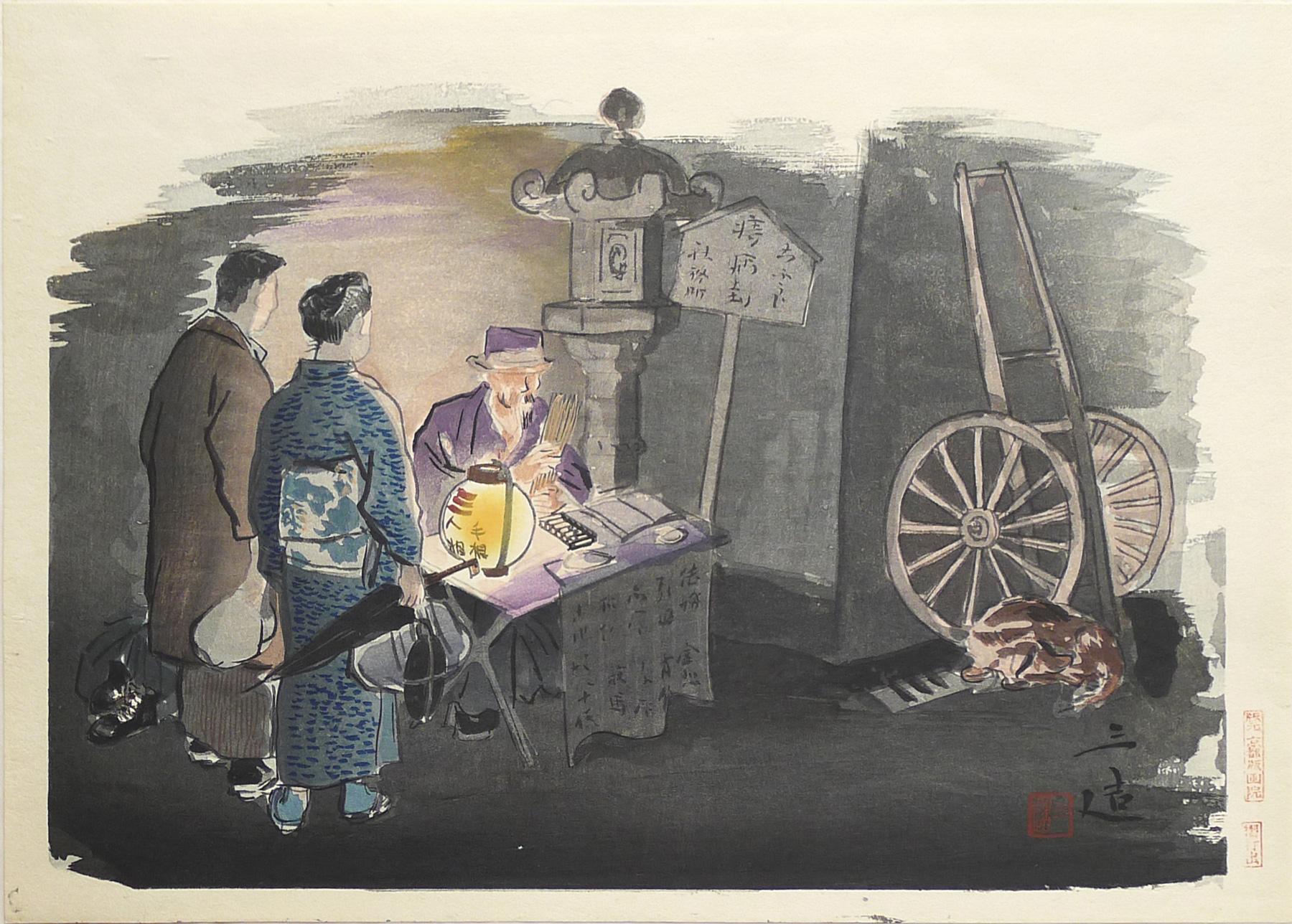About These Prints
[First Edition, 1940, published by Nishinomiya Shoin] The Mainstreet Fortune Teller
For a fee of fifty sen fortunes are told in such diverse areas as marriage, occupation, lost items, missing persons, illness, and the rise and fall of the stockmarket, by means of reading, physiognomy, fortune telling, and onomancy.
At a loss and in dire need they run to this place asking anything that is on their minds.
But what are the conditions for trusting this spokesman? First, half of his hair needs to be grey, and he needs to be very old. He definitely shouldn't wear Western clothes. And even if the color is faded, a kimono with one's family crest and a hakama are considered as absolutely necessary parts of the outfit. However, wearing Chinese or Korean clothing seems to be a way to excite people's curiosity even more.
What is even more interesting is that the buyer, that is, the person who seeks fortune-telling, forgets that they paid fifty sen and put themselves completely at the mercy of the fortune teller.
It is very common to see one or two fortune-tellers in the precincts of a Shinto shrine or a Buddhist temple. Many people who are not well educated are apt to be enthralled by such superstition, and they consult the fortune-teller when their wish to know in regard to change of residence, marriage, loan of money, change of job, trip and in fact nearly all the matters of their daily lives.
Most of the fortune-tellers open their road-side shops in the evening. Judging by his clothing, the husband seems to be a merchant, and he may have asked the fortune-teller to divine what will become of his business. The fortune-teller is trying to find the means by his divining rods.
Depicted by Sanzo Wada. Printed by KYOTO-HANGA-IN
the publisher Kyoto Hangain. One of six chuban size prints
About the Series "Occupations of the Shōwa Era in Pictures"
Sources: website of Ross Walker Ohmi Gallery http://www.ohmigallery.com/DB/Artists/Sales/Wada_Sanzo.asp and website of USC Pacific Asian Museum "Exhibition - The Occupations of Shōwa Japan in Pictures: The Woodblock Prints of Wada Sanzō"
Note:
My special thanks to Shinagawa Daiwa, the current owner of Kyoto Hangain, for providing the below information (in a series of emails in July 2014) about Nishinomiya Shoin and Kyoto Hangain, both businesses started by his father Shinagawa Kyoomi. Shinagawa's current website can be accessed at http://www.amy.hi-ho.ne.jp/kyotohangain/
2 "Out of the Dark Valley: Japanese Woodblock Prints and War, 1937-1945," Kendall H. Brown,p. 82 appearing in Impressions, The Journal of the Ukiyo-e Society of America, Inc., Number 23, 2001.
3 Pacific Asia Museum website http://www.pacificasiamuseum.org/_on_view/exhibitions/2004/occshowa.aspx
4 Light in Darkness: Women in Japanese Prints of Early Shōwa (1926-1945), Kendall H. Brown, et. al., Fisher Gallery, University of Southern California, 1996, p. 18.
| IHL Catalog | #1057; #1075 | ||
| Title/Description | 大道占師 [daidō uranaishi] - Roadside Fortune Teller [number 10] Note: title is printed on original edition print IHL Cat. #1057) but untitled on post-war print IHL Cat. #1075 | ||
| Series | Occupations of Shōwa Japan in Pictures, Series 2 (also seen translated as "Compendium of Occupations in the Shōwa Era" and "Japanese Vocations in Pictures") Shōwa shokugyō e-zukushi 昭和職業繪盡 (also seen written as 昭和職業絵尽し and 昭和職業繪盡し), dainishū (第二輯) | ||
| Artist | Wada Sanzō (1883-1967) | ||
| Signature | 三造 Sanzō | ||
| Seal | Sanzō both seals
| ||
| Publication Date | IHL Cat. #1057 1940; IHL Cat. #1075 c. 1950 | ||
| Publisher |
| ||
| Edition | IHL Cat. #1057 - first edition IHL Cat. #1075 - second edition | ||
| Carver | |||
| Printer | IHL Cat. #1075 - second edition 摺*出 摺*出 | ||
| Impression | IHL Cat. #1057 excellent; IHL Cat. #1075 excellent | ||
| Colors | IHL Cat. #1057 excellent; IHL Cat. #1075 excellent | ||
| Condition | IHL Cat. # 1057 excellent - overall toning; still tipped onto its original backing cardboard IHL Cat. #1075 excellent - light toning, still tipped onto its original backing sheet | ||
| Genre | shin hanga | ||
| Miscellaneous | originally released by Nishinomiya Shoin as print number 10 in series 2 | ||
| Format | dai-oban | ||
| H x W Paper | IHL Cat. #1057 11 3/8 x 15 1/8 in. (28.9 x 38.4 cm) IHL Cat. #1075 11 3/8 x 15 7/8 in. (28.9 x 40.3 cm) | ||
| H x W Image | IHL Cat. #1057 10 1/8 x 14 1/2 in. (25.7 x 36.8 cm) IHL Cat. #1075 9 7/8 x 14 1/2 in. (25.1 x 36.8 cm) | ||
| Collections This Print | Himeji City Museum of Art Ⅲ-184-10 (dated "1939~1940年") | ||
| Reference Literature | Memories of Shōwa: Impressions of Working Life by Wada Sanzō, Maureen de Vries and Daphne van der Molen, Nihon no hanga, 2021 |








